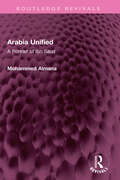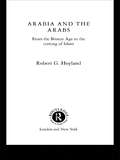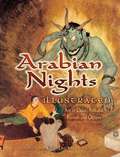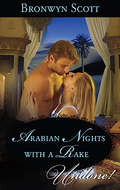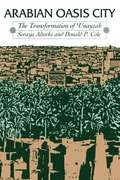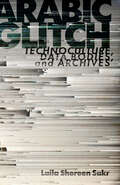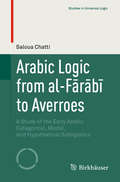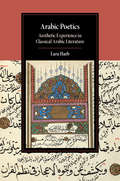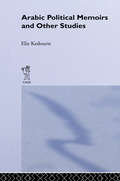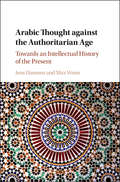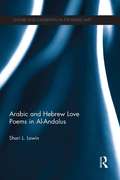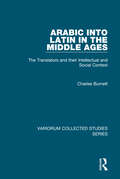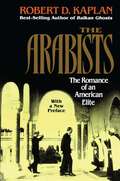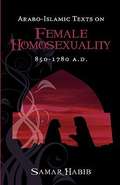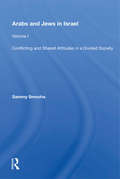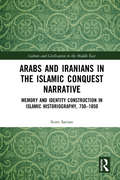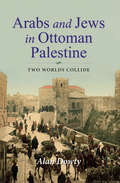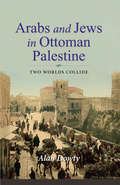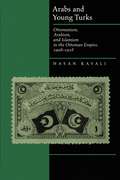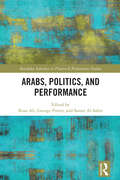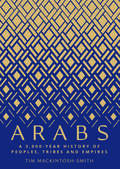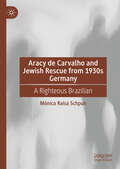- Table View
- List View
Arabia Unified: A Portrait of Ibn Saud (Routledge Revivals)
by Mohammed AlmanaFirst Published in 1980 Arabia Unified presents an insider’s view of Saudi Arabia’s history and the remarkable career of its founder. The book covers the capture of Riyadh from the Saud family’s greatest rivals, the Rashid’s, and the eventual defeat of Al Rashid at the battle of Rowdhat Muhanna; the elimination of Ibn Saud’s most implacable enemies; the incorporation of the provinces of Asir and Hejaz into the kingdom; and the rise, rebellion, and eventual defeat of the puritanical Ikhwan tribesmen. Author describes life with the King’s Bedouin warriors and the intricacies of the Arabian tribal system; the confrontation with the Imam Yahya of the Yemen; and finally, the start of the oil exploration which was to transform the country. The author concludes with his own account of the King’s character and achievements. Full of humor, anecdote and reminiscence, an accurate and personal record, this book is essential reading for all who wish to know about the history of Saudi Arabia.
Arabia and the Arabs: From the Bronze Age to the Coming of Islam
by Robert G. HoylandLong before Muhammed preached the religion of Islam, the inhabitants of his native Arabia had played an important role in world history as both merchants and warriorsArabia and the Arabs provides the only up-to-date, one-volume survey of the region and its peoples, from prehistory to the coming of IslamUsing a wide range of sources - inscriptions, poetry, histories, and archaeological evidence - Robert Hoyland explores the main cultural areas of Arabia, from ancient Sheba in the south, to the deserts and oases of the north. He then examines the major themes of*the economy*society*religion*art, architecture and artefacts*language and literature*Arabhood and ArabisationThe volume is illustrated with more than 50 photographs, drawings and maps.
Arabian Nights Illustrated: Art of Dulac, Folkard, Parrish and Others
by Jeff A. MengesAccording to legend, a resourceful bride won a stay of execution by captivating a sultan with a series of fantastic tales--and after 1,001 nights, the sultan could not bear to part with his storyteller. More than a thousand years later, readers continue to fall under the spell of the romantic adventures known as the Arabian Nights. This original collection features rare and unusual illustrations inspired by the traditional tales of Sinbad, Aladdin, Ali Baba, and a host of other exotic characters.Spanning the decades between the 1890s and the 1920s, this volume draws upon images from the Golden Age of Illustration, when technological advances in printing led to a boom in the publication of artwork. Drawings and paintings by Maxfield Parrish, Edmund Dulac, Charles Folkard, and other acclaimed artists of the era appear here, in more than 185 color and black-and-white illustrations with captions. Abounding in mystery and excitement, these scenes from the timeless tales of heroism will captivate all lovers of fantasy and fairy tales, as well as collectors of rare books and art and illustration enthusiasts.
Arabian Nights with a Rake
by Bronwyn ScottAlgerian Desert, 1833Held captive in a Bedouin camp, Susannah Sutcliffe was bid to dress in scandalous silks and dance for the sheikh's guests. The request wasn't new to Susannah--but the presence of English diplomat Alex Grayfield was a shock she had not anticipated! Handsome and charming, Alex exuded a powerful masculinity that Susannah found irresistible...and he was unmistakably aroused by her sensual dance. Soon, Susannah had a plan to escape her desert captors: convince Alex to rescue her--by seducing him....
Arabian Oasis City: The Transformation of Unayzah
by Soraya Altorki Donald P. ColeVast social change has occurred in the Middle East since the oil boom of the mid-1970s. As the first anthropological study of an urban community in Saudi Arabia since that oil boom, Arabian Oasis City is also the first to document those changes. Based on extensive interviews and participant observation with both men and women, the authors record and analyze the transformation that has occurred in this ancient oasis city throughout the twentieth century: the creation of the present Saudi Arabian state and of a new national economy based on the export of oil and the economic boom brought about by the dramatic increases in the price of oil following the October 1973 Arab-Israeli War. In addition, the authors reveal the changes brought about by the fall in the price of oil beginning in 1982 and analyze the problems confronting 'Unayzah in its aftermath. By demonstrating that the area was not exclusively dominated by tribalism and Bedouin nomads, this empirical case study destroys stereotypical views about Saudi Arabia. Indeed, it proves the existence-prior to the coming of the modern Saudi Arabian state-of surplus agricultural and craft production and the full development of local, regional, and long-distance trade networks. It shows that women, although veiled, played active roles in work outside the household. The social impact of change over the years is, however, profound-especially the gradual replacement of the extended family by the nuclear family, changing patterns of husband-wife relationships, the impact of self-earned income on the status of women, and the emergence of a new middle class of employees and entrepreneurs. Because of the high degree of gender segregation in this area of research, Altorki and Cole give us a fortunate collaboration between a Saudi Arabian female scholar and an American male scholar experienced in research in the Middle East. Both are professors of anthropology at the American University in Cairo.
Arabic Glitch: Technoculture, Data Bodies, and Archives
by Laila Shereen SakrArabic Glitch explores an alternative origin story of twenty-first century technological innovation in digital politics—one centered on the Middle East and the 2011 Arab uprisings. Developed from an archive of social media data collected over the decades following the 2003 U.S. invasion of Iraq, this book interrogates how the logic of programming technology influences and shapes social movements. Engaging revolutionary politics, Arab media, and digital practice in form, method, and content, Laila Shereen Sakr formulates a media theory that advances the concept of the glitch as a disruptive media affordance. She employs data analytics to analyze tweets, posts, and blogs to describe the political culture of social media, and performs the results under the guise of the Arabic-speaking cyborg VJ Um Amel. Playing with multiple voices that span across the virtual and the real, Sakr argues that there is no longer a divide between the virtual and embodied: both bodies and data are physically, socially, and energetically actual. Are we cyborgs or citizens—or both? This book teaches us how a region under transformation became a vanguard for new thinking about digital systems: the records they keep, the lives they impact, and how to create change from within.
Arabic Logic from al-Fārābī to Averroes: A Study of the Early Arabic Categorical, Modal, and Hypothetical Syllogistics (Studies in Universal Logic)
by Saloua ChattiThis monograph explores the logical systems of early logicians in the Arabic tradition from a theoretical perspective, providing a complete panorama of early Arabic logic and centering it within an expansive historical context. By thoroughly examining the writings of the first Arabic logicians, al-Fārābī, Avicenna and Averroes, the author analyzes their respective theories, discusses their relationship to the syllogistics of Aristotle and his followers, and measures their influence on later logical systems. Beginning with an introduction to the writings of the most prominent Arabic logicians, the author scrutinizes these works to determine their categorical logic, as well as their modal and hypothetical logics. Where most other studies written on this subject focus on the Arabic logicians’ epistemology, metaphysics, and theology, this volume takes a unique approach by focusing on the actual technical aspects and features of their logics. The author then moves on to examine the original texts as closely as possible and employs the symbolism of modern propositional, predicate, and modal logics, rendering the arguments of each logician clearly and precisely while clarifying the theories themselves in order to determine the differences between the Arabic logicians’ systems and those of Aristotle. By providing a detailed examination of theories that are still not very well-known in Western countries, the author is able to assess the improvements that can be found in the Arabic writings, and to situate Arabic logic within the breadth of the history of logic. This unique study will appeal mainly to historians of logic, logicians, and philosophers who seek a better understanding of the Arabic tradition. It also will be of interest to modern logicians who wish to delve into the historical aspects and progression of their discipline. Furthermore, this book will serve as a valuable resource for graduate students who wish to complement their general knowledge of Arabic culture, logic, and sciences.
Arabic Philosophy
by Peter Adamson Richard C. TaylorRepresenting one of the great traditions of Western philosophy, philosophy written in Arabic and in the Islamic world was inspired by Greek philosophical works and the indigenous ideas of Islamic theology. This collection of essays, by some of the leading scholars in Arabic philosophy, provides an introduction to the field by way of chapters devoted to individual thinkers (such as al-Farabi, Avicenna and Averroes) or groups, especially during the 'classical' period from the ninth to the twelfth centuries.
Arabic Poetics: Aesthetic Experience in Classical Arabic Literature (Cambridge Studies in Islamic Civilization)
by Lara HarbWhat makes language beautiful? Arabic Poetics offers an answer to what this pertinent question looked like at the height of the Islamic civilization. In this novel argument, Lara Harb suggests that literary quality depended on the ability of linguistic expression to produce an experience of discovery and wonder in the listener. Analyzing theories of how rhetorical figures, simile, metaphor, and sentence construction are able to achieve this effect of wonder, Harb shows how this aesthetic theory, first articulated at the turn of the eleventh century CE, represented a major paradigm shift from earlier Arabic criticism which based its judgement on criteria of truthfulness and naturalness. In doing so, this study poses a major challenge to the misconception in modern scholarship that Arabic criticism was 'traditionalist' or 'static', exposing an elegant widespread conceptual framework of literary beauty in the post-eleventh-century Islamicate world which is central to poetic criticism, the interpretation of Aristotle's Poetics in Arabic philosophy and the rationale underlying discussions about the inimitability of the Quran.
Arabic Political Memoirs and Other Studies
by Elie KedourieFirst Published in 2005. Routledge is an imprint of Taylor & Francis, an informa company.
Arabic Thought Beyond the Liberal Age
by Max Weiss Jens HanssenWhat is the relationship between thought and practice in the domains of language, literature and politics? Is thought the only standard by which to measure intellectual history? How did Arab intellectuals change and affect political, social, cultural and economic developments from the eighteenth to the twentieth centuries? This volume offers a fundamental overhaul and revival of modern Arab intellectual history. Using Hourani's Arabic Thought in the Liberal Age, 1798–1939 (Cambridge, 1962) as a starting point, it reassesses Arabic cultural production and political thought in the light of current scholarship and extends the analysis beyond Napoleon's invasion of Egypt and the outbreak of World War II. The chapters offer a mixture of broad-stroke history on the construction of 'the Muslim world', and the emergence of the rule of law and constitutionalism in the Ottoman empire, as well as case studies on individual Arab intellectuals that illuminate the transformation of modern Arabic thought.
Arabic Thought against the Authoritarian Age: Towards an Intellectual History of the Present
by Max Weiss Jens HanssenIn the wake of the Arab uprisings, the Middle East descended into a frenzy of political turmoil and unprecedented human tragedy which reinforced regrettable stereotypes about the moribund state of Arab intellectual and cultural life. This volume sheds important light on diverse facets of the post-war Arab world and its vibrant intellectual, literary and political history. Cutting-edge research is presented on such wide-ranging topics as poetry, intellectual history, political philosophy, and religious reform and cultural resilience all across the length and breadth of the Arab world, from Morocco to the Gulf States. This is an important statement of new directions in Middle East studies that challenges conventional thinking and has added relevance to the study of global intellectual history more broadly.
Arabic Thought in the Liberal Age
by Albert HouraniArabic Thought in the Liberal Age is the most comprehensive study of the modernizing trend of political and social thought in the Arab Middle East. Albert Hourani studies the way in which ideas about politics and society changed during the nineteenth and the first half of the twentieth centuries, in response to the expanding influence of Europe. His main attention is given to the movement of ideas in Egypt and Lebanon. He shows how two streams of thought, the one aiming to restate the social principles of Islam, and the other to justify the separation of religion from politics, flowed into each other to create the Egyptian and Arab nationalisms of the present century. The last chapter of the book surveys the main tendencies of thought in the post-war years. Since its publication in 1962, this book has been regarded as a modern classic of interpretation. It was reissued by the Cambridge University Press in 1983 and has subsequently sold over 8000 copies.
Arabic and Hebrew Love Poems in Al-Andalus (Culture and Civilization in the Middle East)
by Shari LowinArabic and Hebrew Love Poems in al-Andalus investigates a largely overlooked subset of Muslim and Jewish love poetry in medieval Spain: hetero- and homo-erotic love poems written by Muslim and Jewish religious scholars, in which the lover and his sensual experience of the beloved are compared to scriptural characters and storylines. This book examines the ways in which the scriptural referents fit in with, or differ from, the traditional Andalusian poetic conventions. The study then proceeds to compare the scriptural stories and characters as presented in the poems with their scriptural and exegetical sources. This new intertextual analysis reveals that the Jewish and Muslim scholar-poets utilized their sacred literature in their poems of desire as more than poetic ornamentation; in employing Qur’ānic heroes in their secular verses, the Muslim poets presented a justification of profane love and sanctification of erotic human passions. In the Hebrew lust poems, which utilize biblical heroes, we can detect subtle, subversive, and surprisingly placed interpretations of biblical accounts. Moving beyond the concern with literary history to challenge the traditional boundaries between secular and religious poetry, this book provides a new, multidisciplinary, approach to existing materials and will be of interest to students, scholars and researchers of Islamic and Jewish Studies as well as to those with an interest in Hebrew and Arabic poetry of Islamic Spain.
Arabic into Latin in the Middle Ages: The Translators and their Intellectual and Social Context (Variorum Collected Studies)
by Charles BurnettThis collection of Charles Burnett's articles on the transmission of Arabic learning to Europe concentrates on the identity of the Latin translators and the context in which they were working. The articles are arranged in roughly chronological order, beginning with the earliest known translations from Arabic at the end of the 10th century, progressing through 11th-century translations made in Southern Italy, translators working in Sicily and the Principality of Antioch at the beginning of the 12th century, the first of the 12th-century Iberian translators, the beginnings and development of 'professional' translation activity in Toledo, and the transfer of this activity from Toledo to Frederick II's entourage in the 13th century. Most of the articles include editions of texts that either illustrate the style and character of the translator or provide the source material for his biobibliography.
Arabists: The Romance of an American Elite
by Robert D. KaplanA tight-knit group closely linked by intermarriage as well as class and old school ties, the “Arabists” were men and women who spent much of their lives living and working in the Arab world as diplomats, military attaches, intelligence agents, scholar-adventurers, and teachers. As such, the Arabists exerted considerable influence both as career diplomats and as bureaucrats within the State Department from the early nineteenth century to the present. But over time, as this work shows, the group increasingly lost touch with a rapidly changing American society, growing both more insular and headstrong and showing a marked tendency to assert the Arab point of view. Drawing on interviews, memoirs, and other official and private sources, Kaplan reconstructs the 100-year history of the Arabist elite, demonstrating their profound influence on American attitudes toward the Middle East, and tracing their decline as an influx of ethnic and regional specialists has transformed the State Department and challenged the power of the old elite.
Arabo-Islamic Texts On Female Homosexuality, 850 - 1780 A D
by Samar HabibIncreasingly in mainstream discourse and rhetoric, there only seems to be one very serious and conservative face to Islam, Muslim communities, and their governments. Mainstream modern Islamic hermeneutics condemn homosexual orientations, sometimes with punishments as severe as death. Nevertheless, there were also instances in Muslim history, culture, and society where religiosity was playful not punitive, where the sexual body was inscribed with markers of pleasure not those of perdition. <p><p> Exploring instances within the Arabian Islamic Empire that negate impressions about Muslim cultures as eternally monolithic, conservative, and orthodox, we can come to a better and more nuanced understanding of the complexities of former and contemporary Muslim civilizations. The question of gay and lesbian human rights in the Muslim world is a topical and pressing one, and the need now for alternative ways of approaching Islam in the modern world is more important than ever. The answers to today's modern crisis in human rights for LGBTIQ people lies in looking at the past and highlighting elements that can assist in the creation of a more equitable future. <p> This publication discovers and brings to the English reader an array of surviving texts penned by Muslim scholars discussing female same‐sex desire. From the tolerant days of the Abbasid caliphate to the celebratory text of Yusuf Tifashi in the thirteenth century and onwards toward growing strictures and greater intolerance, Arabo-Islamic Texts reveals a dynamic and lively discourse on sexuality in the Arabo-Islamic empire. The English translation of a lecture delivered in Arabic in Haifa by Samar Habib is also included in this book.
Arabs And Jews In Israel: Volume 1, Conflicting And Shared Attitudes In A Divided Society
by Sammy SmoohaOn December 9, 1987, the Palestinians on the West Bank and Gaza Strip launched the most serious challenge in this century to non-Arab rule in the area West of the Jordan river. A genuine grassroots movement against protracted occupation and for self-determination, the Intifadeh has already inflicted many losses and scored many gains. By the first anniversary of the uprising, the toll for the revolting Palestinians was at least 280 dead, 4,000 wounded, 5,500 detainees, and some deportations and house demolitions. The substantial suffering and privations also entailed numerous beatings, curfews, arrests, searches, cuts in basic services, closings of schools, and losses of income. The Israelis have had 10 killed, 1,150 wounded, a minimum of a 1.5% drop in the Gross National Product, the stress of a people's,army fighting civilians of an occupied nation, increased international isolation and censure, and the straining of relations with the Diaspora.
Arabs and Iranians in the Islamic Conquest Narrative: Memory and Identity Construction in Islamic Historiography, 750–1050 (Culture and Civilization in the Middle East)
by Scott SavranArabs and Iranians in the Islamic Conquest Narrative analyzes how early Muslim historians merged the pre-Islamic histories of the Arab and Iranian peoples into a didactic narrative culminating with the Arab conquest of Iran. This book provides an in-depth examination of Islamic historical accounts of the encounters between representatives of these two peoples that took place in the centuries prior to the coming of Islam. By doing this, it uncovers anachronistic projections of dynamic identity and political discourses within the contemporaneous Islamic world. It shows how the formulaic placement of such embellishment within the context of the narrative served to justify the Arabs’ rise to power, whilst also explaining the fall of the Iranian Sasanian empire. The objective of this book is not simply to mine Islamic historical chronicles for the factual data they contain about the pre-Islamic period, but rather to understand how the authors of these works thought about this era. By investigating the intersection between early Islamic memory, identity construction, and power discourses, this book will benefit researchers and students of Islamic history and literature and Middle Eastern Studies.
Arabs and Jews in Ottoman Palestine: Two Worlds Collide (Perspectives On Israel Studies)
by Alan DowtyThe historian and expert on Israeli-Palestinian relations offers &“a well-written, well-balanced&” account of cultural conflicts in the region before WWI (Anita Shapira, author of Israel: A History).When did the Arab-Israeli conflict begin? Some discussions focus on the 1967 war, some go back to the creation of the state of Israel in 1948, and others look to the beginning of the British Mandate in 1922. Alan Dowty, however, traces the earliest roots of the conflict to the Ottoman Empire in the 19th century, arguing that this historical approach highlights constant clashes between religious and ethnic groups in Palestine. Dowty demonstrates that, during the 19th century, there was an overwhelming hostility to European foreigners, and that Arab residents viewed new Jewish settlers as European. He also shows that Jewish settlers had tremendous incentive to minimize all obstacles to settlement, including the inconvenient hostility of the existing population. Dowty's thorough research reveals how events that occurred over 125 years ago shaped the implacable conflict that dominates the Middle East today.
Arabs and Jews in Ottoman Palestine: Two Worlds Collide (Perspectives on Israel Studies)
by Alan DowtyWhen did the Arab-Israeli conflict begin? Some discussions focus on the 1967 war, some go back to the creation of the state of Israel in 1948, and others look to the beginning of the British Mandate in 1929. Alan Dowty, however, traces the earliest roots of the conflict to the Ottoman Empire in the 19th century, arguing that this historical approach highlights constant clashes between religious and ethnic groups in Palestine. He demonstrates that existing Arab residents viewed new Jewish settlers as European and shares evidence of overwhelming hostility to foreigners from European lands. He shows that Jewish settlers had tremendous incentive to minimize all obstacles to settlement, including the inconvenient hostility of the existing population. Dowty's thorough research reveals how events that occurred over 125 years ago shaped the implacable conflict that dominates the Middle East today.
Arabs and Young Turks: Ottomanism, Arabism, and Islamism in the Ottoman Empire, 1908-1918
by Hasan KayaliArabs and Young Turks provides a detailed study of Arab politics in the late Ottoman Empire as viewed from the imperial capital in Istanbul. In an analytical narrative of the Young Turk period (1908-1918) historian Hasan Kayali discusses Arab concerns on the one hand and the policies of the Ottoman government toward the Arabs on the other. Kayali's novel use of documents from the Ottoman archives, as well as Arabic sources and Western and Central European documents, enables him to reassess conventional wisdom on this complex subject and to present an original appraisal of proto-nationalist ideologies as the longest-living Middle Eastern dynasty headed for collapse. He demonstrates the persistence and resilience of the supranational ideology of Islamism which overshadowed Arab and Turkish ethnic nationalism in this crucial transition period. Kayali's study reaches back to the nineteenth century and highlights both continuity and change in Arab-Turkish relations from the reign of Abdulhamid II to the constitutional period ushered in by the revolution of 1908.Arabs and Young Turks is essential for an understanding of contemporary issues such as Islamist politics and the continuing crises of nationalism in the Middle East.
Arabs, Politics, and Performance (ISSN)
by Samer Al-Saber Roaa Ali George PotterThis book is a ground-breaking collection on contemporary Arab theatre.Through three sections discussing occupation and resistance, diaspora, migration, and refugees, and nationalism and belonging, this study provides nuanced responses to the contested points of intersection between Arab culture and the West, as well as many of the major concerns within contemporary Arab theatre. The collection draws together scholars from the Middle East, North Africa, Europe, and the United States who write about Arab theatre and the representation of Arabs on European and American stages. It introduces concerns in contemporary Arab theatre, the regions in which Arab theatre is performed, and the issues with representations of Arabs onstage.This volume will be of great significance for those interested in expanding the range of global, postcolonial, African, Asian, or diasporic theatre that they study, teach, or stage.
Arabs: A 3,000-Year History of Peoples, Tribes and Empires
by Tim Mackintosh-SmithA riveting, comprehensive history of the Arab peoples and tribes that explores the role of language as a cultural touchstone This kaleidoscopic book covers almost 3,000 years of Arab history and shines a light on the footloose Arab peoples and tribes who conquered lands and disseminated their language and culture over vast distances. Tracing this process to the origins of the Arabic language, rather than the advent of Islam, Tim Mackintosh-Smith begins his narrative more than a thousand years before Muhammad and focuses on how Arabic, both spoken and written, has functioned as a vital source of shared cultural identity over the millennia. Mackintosh-Smith reveals how linguistic developments—from pre-Islamic poetry to the growth of script, Muhammad’s use of writing, and the later problems of printing Arabic—have helped and hindered the progress of Arab history, and investigates how, even in today’s politically fractured post–Arab Spring environment, Arabic itself is still a source of unity and disunity.
Aracy de Carvalho and Jewish Rescue from 1930s Germany: A Righteous Brazilian
by Mônica Raisa SchpunAracy de Carvalho (1908-2011), 'Righteous Among the Nations', saved German Jews by facilitating their emigration to Brazil in the late 1930s, while working at the Brazilian consulate in Hamburg. Margarethe Levy (1908-2011), who left for Brazil shortly after Kristallnacht with her husband, was one such case. In the late 1970s, she claimed the title of Righteous from Yad Vashem for Carvalho, who had become her lifelong friend. The main thread of this book follows the crossed migrations of these two women between Brazil and Germany, and the long friendship that brought them together. Through this axis it traces the migratory paths of a group of German Jews who, like Levy, left Hamburg to settle in São Paulo.
